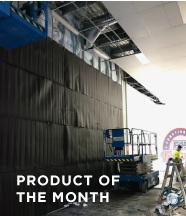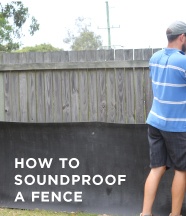Soundproof Warehouse FAQs
Acoustic Fence Wrap
- How much noise will be reduced once Acoustic Fence Wrap is installed?
If your fence or structure is acoustically transparent you will get a 50% drop of noise to the human ear, 10dB drop.
- How high do I need to go?
A standard fence is anywhere between 1.8m – 2m tall. We need to go to the full height of the fence to reduce unwanted noise. Basically the higher the barrier the better the reduction.
- Does the Acoustic Fence Wrap reflect noise?
The Acoustic Fence Wrap will absorb around 20-25% of noise. The lower frequencies will be absorbed more than higher frequencies due to the nature and properties of the material.
- How long does it take to install Acoustic Fence Wrap?
It usually takes about 2hrs to install a 10-meter-long fence @ 1.8 meters tall with 2 people.
- What fixings should I use?
For a timber fence, we recommend 45mm timber wafer head screws with 1inch washers. Refer to install instructions.
- What happens if the ground is uneven, how do I solve this problem?
Soil can be put into the holes. We do not want any holes under the Acoustic Fence Wrap as sound waves will travel along the ground. The product will not rot when it touches the ground or if the soil is placed along the bottom of the material.
Sound Stop 5
- Can I install Sound-Stop 5 on steel and timber stud frames?
Yes. Use wafer head screws or staples on timber stud. Use self-drilling wafer head screws on steel stud. Install as per install instructions.
- Can Sound-Stop 5 be use in ceilings?
Yes. It can be laid on top of the flooring joists or installed on the underside of the ceiling. A resilient channel as a minimum should be used on the underside of the joists so the plasterboard is decoupled from the ceiling. Refer to the install instructions.
- Can Sound-Stop 5 be used outside?
Yes, it can but it must be in a static position and covered with a protective layer like timber or fibre cement sheet. As wind over time will fatigue the material.
- Can I sandwich Sound-Stop 5 between plasterboard?
Yes, you can. This will add more mass to the assembly and increase transmission loss. Ideally, we would love an air gap for the material to vibrate in the assembly to perform to its maximum potential. But sometimes this is not always possible in construction situations.
- Is it ok to screw through Sound-Stop 5?
Yes. The material is self-healing and will seal around the screw.
- What happens if I rip the material when installing?
You can use Fuller Fire Sound Acoustic Sealant to seal the join. Then use SuperGrip Tape to hold the join.
Acoustic Windows
- How much noise is reduced once the new addon window is installed?
Usually we get around a 10dB drop which is a 50% drop to the human ear, for a brick veneer wall assembly. Sometimes we get less if it is an old weatherboard Queenslander as the new window system will outspec the walls in acoustic control. But a good perceived noise reduction will be noticed.If the property has concrete walls, we would expect to get a 70% reduction in noise.
- Do you remove the existing window?
No. We do not touch the existing window. We usually put the new frame work on the inside of the reveal and match the new sliding panels with the existing window panels.
- How do I clean the windows once the new secondary glazing is installed?
All the new window panels will slide so you can get access to the original window panels. The new window panels will pop out too if you need to get access.
- How long does it take to install an addon window?
It usually takes about 50mins to install the new window system.
- What type of glass is used?
We usually use Grade A Safety 6.38 laminated glass which is sufficient in most residential cases.
- Why use laminated glass?
Laminated glass is 2 layers of 3mm glass with an interlayer that is 0.38mm thick. This helps the noise to decay and reduce on exiting the window assembly.
Acoustic Blanket
- Do the blankets absorb noise?
Yes, the Acoustic-Blankets have a very high absorption rating NRC of .85. (Highest possible is 1.)
- Can I cut the Acoustic-Blankets?
No. The blankets are not designed for cutting.
- How are the blankets joined together?
The blankets have super tuff Velcro on all sides to fix the blankets together with an overlap of 50mm.
- Can the blankets get wet?
Yes, the blankets are designed to be used outside and can be used in inclement weather.
- What about the sun and UV rays, will they affect the Acoustic-Blankets?
The Acoustic-Blankets have been designed with these elements in mind and all the materials are UV stable.
Fibertex
- Can I install in walls behind plasterboard?
Yes you can. As this product is an industrial application it will need to be cut down to size. This product is very dense and heavy and will control noise inside walls.
- Can I cut Fibertex?
Yes, you can cut with a hand saw or large Fatmax Stanley knife and straight edge. Always use the correct PPE when using hand tools.
- Can I use Fibertex to make my own sound absorber?
Yes. A good idea is to make a frame to go on the outside perimeter of the fibertex product. Wrap the product with a breathable product like a cotton fabric. Staple to the frame and hang or place in the required location.
- Can I Install directly on walls to absorb noise?
Yes, ideally you would do this in an industrial application where appearance is not an issue as the product is fibrous. Many builders will use fibertex around pool pumps and install inside generator bays to control reverberation.
- How do I fix Fibertex to a Surface?
We recommend mechanically fixing to a structure with 4 fixings and a large washer hold in position.
Fire Sound Acoustic-sealant
- Where do I use Fire Sound Acoustic Sealant?
- Fire Sound Acoustic Sealant should be used on small penetrations to seal the opening in the wall assembly.
- It should be used when joining 2 layers of Sound-Stop 5 together to create an acoustic seal.
- When joining a wall and ceiling plasterboard assembly together. The Fire Sound Acoustic Sealant should be beaded in the join to decouple both ceiling and wall plasterboard form each other to stop noise flanking.
- Can I use Fire Sound Acoustic Sealant it as an Adhesive?
No. It is not recommended to use an adhesive to structurally bond materials together at high strength.
Outback Acoustic Panels
- How much sound will an Outback Acoustic Panels stop?
The panels will stop 33dB of noise. This will sound like 100dB been reduced by a set of earplugs placed into the receiver’s ear.
- How much sound do the panels absorb?
The panels have a rating of a NRC of 1 which means they have the highest sound absorption possible.
- Can the Outback Acoustic Panels get wet?
Yes absolutely. The panels are designed for heavy rain. Panels have drain holes for the water to escape. Water will not affect the acoustical performance of the panels.
- Can I power wash the panels?
Yes, the panels can be power washed to get rid of dust or any other unsightly contaminants.
- Can the panels be cut?
Let’s say no – as we custom size the panels to suit. But if you have welding equipment you can reweld the frame back together if required.
- Can I screw fixings into the panel?
Yes. We recommend fixing into the 3mm framework only with a self-drilling screw. It is not recommended to screw into the perforated or flat sheet.
- Which way do the panels face?
The perforated face always faces closest to the noise source.
Resilient Channel
- Where should I use a resilient channel?
A resilient channel a designed to decouple the plasterboard from the structure. We always recommend using resilient channels on the ceiling in conjunction with Sound Stop 5. The resilient channel will reduce impact noise coming down through the floor and increase transmission loss.
- Can I cut the channel?
Yes. Simply cut with a snips or grinder. Always remember to use the correct PPE.
- Can I use the resilient channel on a wall?
Yes, you sure can. If you are looking to increase the transmission loss around another 3dB-5dB it is a cost-effective way to increase transmission loss.
- What fixings should I use?
We recommend using self-drilling plasterboard screws. Always use fixings that are long enough to penetrate the plasterboard and resilient channel but will not puncture the Sound-Stop 5.
Sound Stop Foam Composite
- Can I install Sound-Stop Foam Composite on pipes?
Yes. The foam is closest to the pipe and is taped with super grip tape on the joins to hold the Sound-Stop Foam Composite on the pipe.
- How does Sound-Stop Foam Composite work?
The foam absorbs the noise and decouples the heavy vinyl which acts as a noise barrier by vibrating and turning the sound energy into heat energy.
- How do I cut Sound-Stop Foam Composite?
It can be cut with a Stanley knife and straight edge or industrial scissors.
- Can Sound-Stop Foam Composite get wet?
No. It is not designed to get soaking wet. A small amount of water will not damage the material but prolonged exposure to water will damage the foam.
Super Grip Tape
- Why should I use Super Grip Tape?
Super Grip Tape has been designed to adhere to the Sound-Stop 5. Other tapes will peel over time as some adhesives will not work with the plasticizers in Sound-Stop 5.
- How much noise does Super Grip Tape stop?
Super Grip Tape does not stop noise it is used to join the Sound-Stop 5 together to create an acoustic seal.
- How do I cut the tape?
The Super Grip Tape has to be cut with a Stanley knife or scissors. The tape cannot be ripped by hand.
- What is the Tape made from?
The tape is made from a robust ripstop fiberglass fine weave mesh. The adhesive is a specially formulated permanent acrylic adhesive.
- How is Super Grip Tape applied?
Pell off the liner backing of the tape and slowly apply Super Grip Tape to the area that needs to be sealed. The tape needs a firm pressure and must be rubbed by your hand as this applies heat and pressure which in turn activates the adhesive to adhere to the substrates.
Stratocell® Whisper™
- How much noise do the panels stop?
The panels are excellent for absorbing noise, with an NRC of 1 which means the highest absorption possible. The panels have an STC/Rw of 14 which means a 14-dB drop.
- Can I cut the Stratocell® Whisper™?
Yes, the Stratocell® Whisper™ can be cut with a Circular saw or sharp knife and straight edge to required size.
- Can I paint the panels?
No, the panels cannot be painted as this will affect the noise absorption qualities of the product.
- Can the panels be used outside and inside?
They are two types of panels a fire-resistant panel (FR) and an ultraviolet (UV) panel.
A FR panel must be used inside for fire regulations.
A UV panel must be used outside as UV additives are added to this panel for UV stability.
- Can the panels get wet?
Yes, it is ok for the panels to get wet on the front face. But a capping must be placed on top to stop water/rain from entering the top of the panel.
- How are the panels Fixed?
The Stratocell® Whisper™ can be mechanically fixed with 8 fixings if attached to a wall. 3 fixings on each side and 2 in the center with a large washer. Product can also be attached by using a polyethylene adhesive like 3M 90 High Strength adhesive.


















